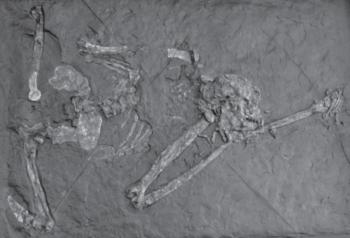 SKC Films Library SKC Films Library |
| SKC Films Library >> Anthropology >> Human Evolution |
| Oreopithecus bambolii pre-human, ape, monkey, or something else? Oreopithecus bambolii [the genus name refers to a Greek word for "hill or mountain"] lived about 7 to 9 million years ago in what are now the Tuscany and Sardinia regions of Italy. It probably stood about 4 feet tall, weighed about 66-77 pounds, had long arms, and was most likely a vegetarian. These are about the only "facts" agreed upon by most paleontologists. The first Oreopithecus fossils were unearthed by French anthropologist Paul Gervais in 1872. Additional specimens were found over the subsequent years, but the first full skeleton was not found until 1958, by Swiss paleontologist Johannes Hürzeler in a coal bed near Baccinello, Italy. Many of the skeleton's features led Hürzeler and some of his colleagues to suggest that Oreopithecus was a member of the Hominid (human) family and that it habitually walked on two legs. Others, however, saw far more monkey features in Oreopithecus and were convinced that it most likely moved through the trees by swinging from branch to branch like many modern-day monkeys (and some apes). Oreopithecus skeleton found at
Baccinello Johannes Hurzeler examining the
Oreopithecus skeleton found at Baccinello In the 1990's, Meike Köhler and Salvador Moyà-Solà of the Miquel Crusafont Catalan Institute of Paleontology of Spain took another look at Oreopithecus and concluded that its ability to walk on two legs was a case of convergent evolution, a process whereby two unrelated organisms evolve similar physical traits as a result of having to adapt to similar environments or ecological niches. When Oreopithecus lived, much of what is now Italy was a string of islands. Because islands tend to have few major predators, most animals can safely move about on the ground. Many of the best food resources may be up in the trees, however, so an ability to move through trees can be a distinct advantage. An animal that can take advantage of far-flung tree-borne food resources by walking between them has an even greater advantage. According to Köhler and Moyà-Solà, Oreopithecus was an ancient ape, but in no way related to hominids. While most paleontologists today agree that Oreopithecus is not part of the homind line, there is still disagreement as to exactly where in the primate line it belongs. There is also disagreement concerning its ability to walk on two legs, with more recent research suggesting that Oreopithecus lacked the pelvic and spinal structure necessary for necessary for regular bipedal locomotion and that it most likely only walked on two legs for brief "spurts" (similar to the occassional "running around" typical of modern chimpanzees). SOURCES |
| SKC Films Library >> Anthropology >> Human Evolution This page was last updated on 05/25/2017. |

